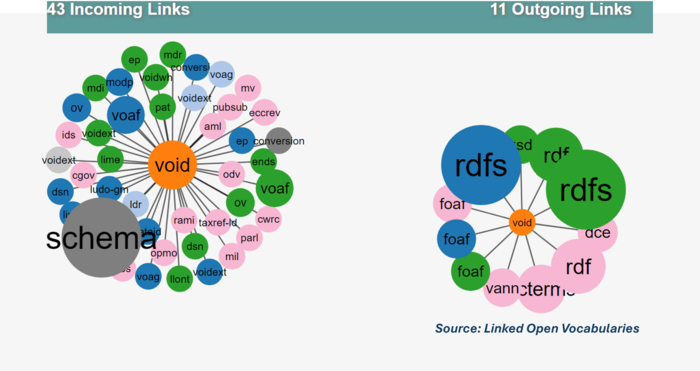Difference between revisions of "Vocabulary of Interlinked Datasets (VoID)"
| Line 1: | Line 1: | ||
== What is Vocabulary of Interlinked Datasets (VoID)? == | == What is Vocabulary of Interlinked Datasets (VoID)? == | ||
'''Vocabulary of Interlinked Datasets (VoID)''' is an RDF Schema vocabulary designed to express metadata about RDF datasets. It is particularly useful for datasets that are part of the Linked Open Data cloud, which involves publishing structured data to be interlinked and more useful. VoID enables dataset publishers to provide information about the datasets, their interlinks, and other metadata in a standardized format, facilitating better discovery, automation, and integration processes. | '''Vocabulary of Interlinked Datasets (VoID)''' is an RDF Schema vocabulary designed to express metadata about RDF datasets. It is particularly useful for datasets that are part of the Linked Open Data cloud, which involves publishing structured data to be interlinked and more useful. VoID enables dataset publishers to provide information about the datasets, their interlinks, and other metadata in a standardized format, facilitating better discovery, automation, and integration processes. | ||
| + | |||
| + | |||
| + | [[File:Vocabulary of Interlinked Datasets (VoID).png|700px|Vocabulary of Interlinked Datasets (VoID).]] | ||
Revision as of 13:49, 8 May 2024
What is Vocabulary of Interlinked Datasets (VoID)?
Vocabulary of Interlinked Datasets (VoID) is an RDF Schema vocabulary designed to express metadata about RDF datasets. It is particularly useful for datasets that are part of the Linked Open Data cloud, which involves publishing structured data to be interlinked and more useful. VoID enables dataset publishers to provide information about the datasets, their interlinks, and other metadata in a standardized format, facilitating better discovery, automation, and integration processes.
Role and Purpose of VoID
The primary role of VoID is to provide a framework for describing RDF datasets, emphasizing datasets that are part of the Semantic Web. Its purpose includes:
- Describing datasets: Information about a dataset, such as its name, description, and creator.
- Expressing linkage: Details on how datasets are interlinked, for example, specifying the datasets to which a given dataset is connected.
- Facilitating dataset discovery: Metadata that helps users and software find datasets and understand their structure and usage.
Usage of VoID
VoID is used in several ways:
- Metadata Publishing: Dataset publishers can use VoID to describe their data, making it easier for users and applications to understand what the data entails and how it can be used.
- Dataset Discovery and Exploration: Tools and applications use VoID descriptions to find relevant datasets, navigate between different datasets, and execute queries across multiple sources.
- Integration and Linkage: Developers use VoID to determine potential links between datasets and to integrate data from various sources more efficiently.
Importance of VoID
VoID is important because it standardizes the way metadata about RDF datasets is expressed, which facilitates:
- Enhanced Data Interoperability: By providing a standard way to describe how datasets are interconnected, VoID helps in integrating data from diverse sources, which is crucial for the Semantic Web.
- Improved Data Discovery: Metadata described by VoID supports better indexing and discovering datasets, which is essential for researchers, developers, and businesses.
- Efficient Data Management: Helps in managing large-scale datasets by providing clear and structured metadata about the data’s content and interrelationships.
Benefits of VoID
The benefits of using VoID include:
- Standardization: Offers a consistent method to describe the datasets, promoting uniformity across data publishers.
- Increased Visibility: Enhances the visibility of datasets within the Linked Data cloud, promoting wider usage and connectivity.
- Better Data Connectivity: Facilitates linking related datasets, enhancing the richness and value of data applications.
Examples of VoID Usage
- Publishing Metadata for a Government Dataset: A government portal could use VoID to describe and link datasets related to demographics, economics, and public services.
- Academic Research: Researchers can use VoID to describe and link datasets about scientific experiments, publications, and citations.
- Corporate Data Management: Corporations can use VoID to manage and link internal datasets about products, sales, and customer interactions for better business intelligence.
VoID plays a crucial role in the Linked Data ecosystem by providing the necessary infrastructure to describe, link, and discover datasets effectively.
See Also
- Resource Description Framework (RDF): Explaining the basic framework and syntax for describing resources and their properties on the web, which is foundational for understanding VoID.
- SPARQL: Detailing the query language for retrieving and manipulating data stored in RDF format. Since VoID is used to describe RDF datasets, understanding SPARQL is crucial for querying these datasets.
- Linked Data: Discussing the principles and practices of linked data, which involve using the web to connect related data that wasn't previously linked. VoID is a key vocabulary in this context.
- Semantic Web: Outlining the broader initiative of which VoID is a part, aimed at enabling data to be shared and reused across application, enterprise, and community boundaries.
- OWL (Web Ontology Language): Describing another semantic web technology used for representing rich and complex knowledge about things, groups of things, and relations between things.
- Dataset Description: Covering how datasets can be described for discovery and reuse, which is the primary purpose of VoID.
- Data Cube Vocabulary: Explaining another vocabulary used for describing statistical data in RDF. This could be relevant if the VoID described datasets include statistical data.
- Simple Knowledge Organization System (SKOS): Discussing how SKOS is used for representing knowledge organization systems such as thesauri, classification schemes, subject heading systems, or taxonomies within the semantic web, which could link to or be used alongside VoID.
Provenance: Outlining the importance of tracking the origin and history of datasets, which can be an aspect of dataset descriptions in VoID.

